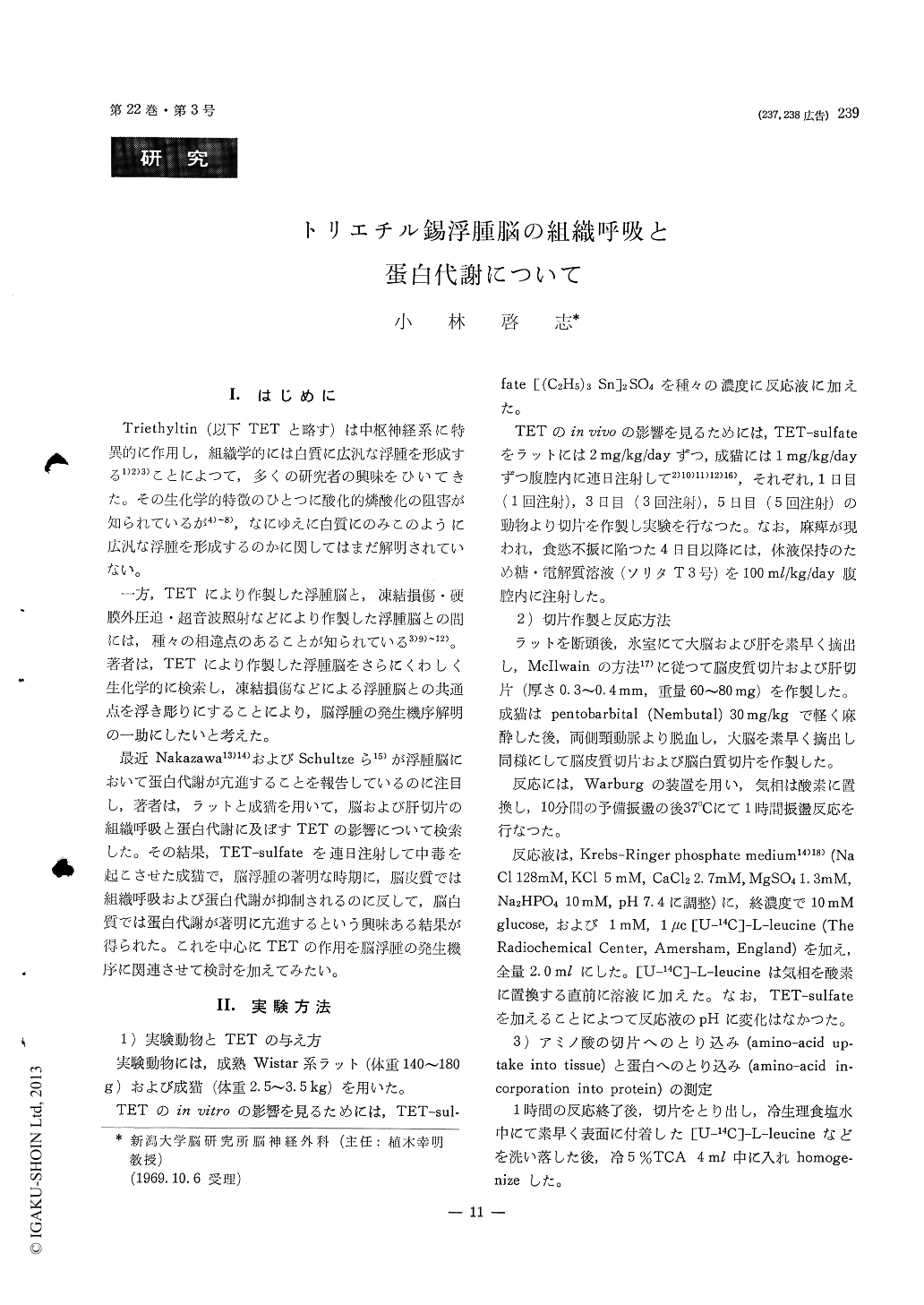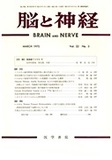Japanese
English
- 有料閲覧
- Abstract 文献概要
- 1ページ目 Look Inside
I.はじめに
Triethyltin (以下TETと略す)は中枢神経系に特異的に作用し,組織学的には白質に広汎な浮腫を形成する1)2)3)ことによって,多くの研究者の興味をひいてきた。その生化学的特徴のひとつに酸化的燐酸化の阻害が知られているが4)〜8),なにゆえに白質にのみこのように広汎な浮腫を形成するのかに関してはまだ解明されていない。
一方,TETにより作製した浮腫脳と,凍結損傷・硬膜外圧迫・超音波照射などにより作製した浮腫脳との間には,種々の相違点のあることが知られている3)9)〜12)。著者は,TETにより作製した浮腫脳をさらにくわしく生化学的に検索し,凍結損傷などによる浮腫脳との共通点を浮き彫りにすることにより,脳浮腫の発生機序解明の一助にしたいと考えた。
Triethyltin (TET) produces an edematous swell-ing of the white matter of the central nervous sys-tem. One of its biochemical effects is the inhibition of oxidative phosphorylation but the mechanism of cerebral edema produced by TET remains unknown.
The present work is an attempt to elucidate the biochemical effects of TET on respiration and pro-tein synthesis and to find out the mechanism of cerebral edema production.
Slices of rat brain cortex and liver and of cat brain cortex and white matter were incubated in Krebs-Ringer phosphate medium with 10 mM glu-cose and the respiratory activity was measured us-ing the standard Warburg manometric technique. To study protein synthesis, the slices were incubated for 60 minutes in a medium containing 1 mM and 1μc (U-14C) leucine. Protein isolated from the TCA-insoluble fraction was dried and weighed and its radioactivity was counted in a gas-flow counter. Leuine uptake into tissues was measured from the radioactivity of TCA-soluble fraction.
Triethyltin-sulfate was added to the medium to study its effect in vitro. And to examine its effect in vivo, it was injected intraperitoneally to rats at the daily dose of 2 mg/kg body weight and also to cats at 1 mg/kg for one to five days.
1) When TET was added to tissue slices in vitro, protein synthesis and oxygen uptake were inhibited at high TET concentration. However, at lower con-centration, the protein synthesis was inhibited but the oxygen uptake slightly increased. Rat brain cortex slices were more sensitive to the inhibitory action of TET compared with its liver, while cat brain white matter slices were less sensitive than its brain cortex.
2) Similarly with the administration of TET in vivo, protein synthesis and oxygen uptake of rat brain cortex and liver slices were inhibited, the brain cortex being more severely affected than liver. 3) With the injection of TET to cat at the daily dose of 1 mg/kg, despite its marked inhibition in brain cortex slices, the protein synthesis of the white matter increased remarkably on the fifth day, the time when its prominent edematous changes are already confirmed to occur in previous biochemical and electro-microscopic studies.
4) TET had no significant effect on leucine up-take into brain cortex, brain white matter and liver slices.
Recently protein synthesis was reported to in-crease in the edematous brain produced by cold injury (Nakazawa) and in the neuroglial cells during experimental edema caused by epidural compression (Schultze, et al.). This paper discusses this increase in the edematous white matter of cats given TET in vivo, in relation to the mechanism of brain edema production.

Copyright © 1970, Igaku-Shoin Ltd. All rights reserved.


